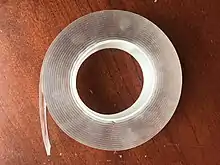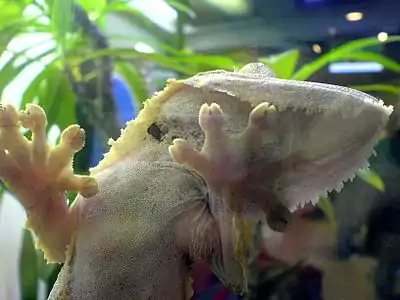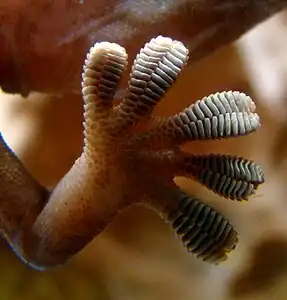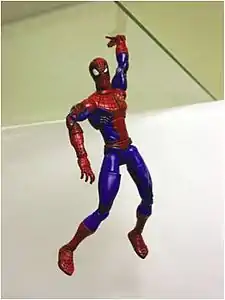Nano tape
Nano tape, also called gecko tape; marketed under the name Alien Tape, is a synthetic adhesive tape consisting of arrays of carbon nanotubes transferred onto a backing material of flexible polymer tape. These arrays are called synthetic setae and mimic the nanostructures found on the toes of a gecko; this is an example of biomimicry. The adhesion is achieved not with chemical adhesives, but via van der Waals forces, which are weak electric forces generated between two atoms or molecules that are very close to each other.[1][2]


Explanation
Geckos show a remarkable ability to climb smooth vertical surfaces at high speeds, exhibiting both strong attachment and easy rapid removal, or shear adhesion, of their feet.[3]
On a gecko's foot, micrometer-sized elastic hairs called setae are split into nanometer-sized structures called spatulas. The shear adhesion is achieved by forming and breaking van der Waals forces between these microscopic structures and the substrate.[4]
Nano tapes mimic these structures with carbon nanotube bundles, which simulate setae, and individual nanotubes, which simulate spatulas, to achieve macroscopic shear adhesion and to translate the weak van der Waals interactions into high shear forces. The shear adhesion allows the tape to be easily peeled off, in the manner a gecko lifts its foot. Since the carbon nanotube arrays leave no residue on the substrate, the tape can be reused many times.[5]
History
Nano tape is one of the first developments of synthetic setae, which arose from a collaboration between the Manchester Centre for Mesoscience and Nanotechnology, and the Institute for Microelectronics Technology in Russia. Work started in 2001 and two years later results were published in Nature Materials.[6]
The group prepared flexible fibers of polyimide as the synthetic setae structures on the surface of a 5 μm thick film of the same material using electron beam lithography and dry etching in an oxygen plasma. The fibres were 2 μm long, with a diameter of around 500 nm and a periodicity of 1.6 μm, and covered an area of roughly 1 cm2 (see figure on the left). Initially, the team used a silicon wafer as a substrate, but found that the tape's adhesive power increased by almost 1,000 times if they used a soft bonding substrate such as Scotch tape. This is because the flexible substrate yields a much higher ratio of the number of setae in contact with the surface over the total number of setae.
The result of this "gecko tape" was tested by attaching a sample to the hand of a 15 cm high plastic Spider-Man figure weighing 40 g, which enabled it to stick to a glass ceiling, as is shown in the figure. The tape, which had a contact area of around 0.5 square centimetres (50 mm2) with the glass, was able to carry a load of more than 100 grams (3.5 oz). However, the adhesion coefficient was only 0.06, which is low compared with real geckos (8~16).
Commercial use
Commercial nano tape is usually sold as double-sided tape that is useful for hanging lightweight items such as pictures and decorative items on smooth walls without punching holes in the wall. Using superaligned carbon nanotubes, some nano tapes can stay sticky in extreme temperatures. [2]
Gallery
 Gecko climbing a glass surface
Gecko climbing a glass surface Close view of a gecko's foot
Close view of a gecko's foot Micro and nano view of gecko's toe
Micro and nano view of gecko's toe Micro view of nano tape[6]
Micro view of nano tape[6] "Spider-Man test" of nano tape[6]
"Spider-Man test" of nano tape[6]
References
- Bourzacarchive, Katherine (2008-10-09). "Sticky Nanotape". MIT Technology Review.
- Nanowerk News (2019-07-10). "Carbon nanotube tape stays sticky in extreme temperatures". Nanowerk Newsletter. American Chemical Society.
- Autumn, Kellar (2006-01-01). "How Gecko Toes Stick". American Scientist. 94 (2): 124. doi:10.1511/2006.58.124.
- Autumn, Kellar; Gravish, Nick (2008-05-13). "Gecko adhesion: evolutionary nanotechnology". Philosophical Transactions of the Royal Society A: Mathematical, Physical and Engineering Sciences. 366 (1870): 1575–1590. Bibcode:2008RSPTA.366.1575A. doi:10.1098/rsta.2007.2173. PMID 18192170. S2CID 16412336.
- Ge, Liehui; Sethi, Sunny; Ci, Lijie; Ajayan, Pulickel M.; Dhinojwala, Ali (2007-06-26). "Carbon nanotube-based synthetic gecko tapes". Proceedings of the National Academy of Sciences. 104 (26): 10792–10795. Bibcode:2007PNAS..10410792G. doi:10.1073/pnas.0703505104. PMC 1904109. PMID 17578915.
- Geim, A.K., Dubonos, S.V., Grigorieva, I.V., Novoselov, K.S., Zhukov, A.A. and Shapoval, S.Y. (2003), "Microfabricated adhesive mimicking gecko foot-hair", Nature Materials, v.2, pp.461–3